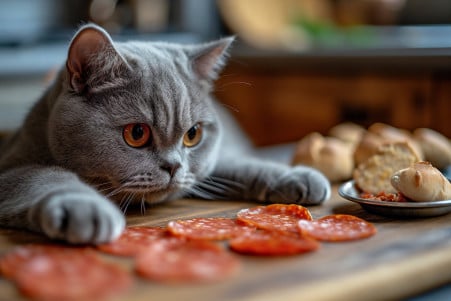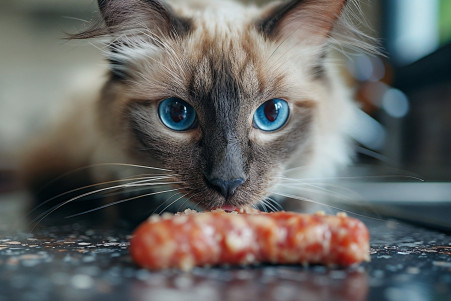Can Cats Have Hot Dogs? Know the Risks and Other Options
4 February 2024

Even if the smell of a hot dog on the grill is appealing to your cat, is it a good idea to let them have a taste? No, cats cannot have hot dogs because they are full of unhealthy ingredients like high levels of sodium, fat, and preservatives.
These can cause a variety of health problems in cats, including dehydration, obesity, and sodium-ion poisoning. In general, treats should be given in moderation and should not be processed.
This in-depth article will take a deep dive into veterinary science, feline nutrition research, and toxicology studies to explain the dangers and health risks of feeding hot dogs to cats. We will look at the nutritional requirements of cats, the impact of processed foods like hot dogs on their health, and explore healthier dietary choices. This will help you understand the best way to keep your cat healthy and well-fed.
Can cats eat hot dogs?
Know the Nutritional Needs of Cats
According to the Cornell University College of Veterinary Medicine, cats are obligate carnivores, which means that they have a biological requirement for nutrients that are found only in animal tissue. This makes it necessary for their diet to be high in protein, which is important for their overall health and well-being. A proper balance includes high protein, moderate fat, and low carbohydrates.
These specific dietary needs mean that proteins, essential fatty acids, vitamins, and minerals are especially important in a cat’s diet. As the VCA Animal Hospitals explains, cats need certain amino acids, including taurine and arginine, and essential fatty acids like arachidonic acid, all of which are important nutrients that are naturally found in animal tissues.
Feeding cats a diet that doesn’t meet these high-protein, moderate-fat, and low-carbohydrate requirements can lead to problems like nutritional deficiencies and health issues.
Cats need these essential nutrients to stay healthy, and it’s important that their diet includes what they need based on their natural diet. Any significant deviation from this, especially if a cat is regularly eating inappropriate human foods or low-quality treats, can lead to health problems. This is important to keep in mind when evaluating the appropriateness of any food for cats, including processed cat food.
How Processed Foods Affect Cats
Processed human foods like hot dogs can have a number of negative effects on cats. For example, these foods are often high in sodium and fat, which can lead to dehydration and obesity in cats.
The Animal Care Clinic notes that regular consumption of processed human foods can result in sodium-ion poisoning, hypertension, and other serious health problems in cats. Hot dogs are especially high in these harmful ingredients, making them particularly bad for cats.
In addition, the preservatives and additives that are used to keep hot dogs fresh for long periods of time are not good for cats. According to The Journal of Small Animal Practice, these chemicals can have negative effects on pets and are often more toxic to animals than people. This is especially problematic for cats, who can’t process the nitrates, nitrites, and other additives in processed human foods like hot dogs.
Obesity and diabetes, two conditions that are often associated with the consumption of processed foods in people, are more complicated when it comes to cats. For example, a study published in PMC explains that while dietary carbohydrates have been implicated in the development of these diseases, environmental factors and the sedentary lifestyle of indoor cats may play a larger role in the development of these conditions.
This underscores the importance of feeding cats a well-balanced diet and ensuring they have an enriching environment, while avoiding processed human foods that aren’t designed to meet their nutritional needs.
Why Cats Need Treats
In addition to being a way to show your cat love, treats can also be used as a form of positive reinforcement when training your cat. VCA Animal Hospitals recommends that treats make up no more than 10% of your cat’s daily caloric intake, and ideally less than 5%. If cats eat too many treats, they can throw off the nutritional balance of their diet, leading to picky eating and even obesity.
When choosing treats for your cat, it’s important to look for high-quality options that are also nutritious. Preventive Vet warns against using hot dogs as treats because they are high in sodium and contain preservatives that can be harmful to cats. Instead, opt for low-calorie treats like small pieces of cooked meat or treats that are specially formulated to meet a cat’s nutritional needs.
By paying attention to the quality of the treats you choose and making sure to feed them in moderation, you can help ensure that your cat stays healthy while still enjoying the occasional treat. When you’re mindful about the treats you give your cat, you can make sure that you’re using them to enhance your cat’s diet and well-being, rather than detract from it.
Cat Digestive System and the Dangers of Human Foods
Knowing how the cat digestive system works explains why certain human foods, especially highly processed ones like hot dogs, can be so dangerous for your pet. Cats have no real chewing teeth and don’t produce the enzyme salivary amylase, which is necessary for breaking down carbohydrates, so they aren’t well-equipped to digest plant-based or highly processed foods.
As Cats.com notes, a cat’s digestive process starts in the stomach, which is an acidic environment that’s meant to digest animal proteins and kill bacteria, not process the wide variety of foods humans eat.
When cats eat hot dogs, they’re taking in high levels of fat and salt that their bodies aren’t built to handle, which can lead to a range of digestive issues from vomiting to more serious problems like gastroenteritis or pancreatitis, according to the Merck Veterinary Manual. Signs of these problems can include lethargy, depression, and loss of appetite.
Catit Magazine adds to this by explaining the liver and pancreas’ roles in absorbing nutrients and detoxifying the body, which shows the importance of feeding cats a diet that supports these critical functions.
The colon’s role in producing vitamins and absorbing water also shows the importance of feeding cats a diet that supports these specialized functions. By meeting cats’ nutritional needs, we can help ensure their digestive system works the way it’s supposed to, keeping them healthy and free from discomfort or serious health issues.
How to Spot and Manage Food Allergies and Intolerances in Cats
While food allergies and intolerances in cats are often overlooked, they can be a major concern in feline nutrition. The Cornell Feline Health Center explains that food allergies are the third most common allergy in cats, following flea bite and inhaled allergies, and can cause both skin and gastrointestinal issues.
Beef, fish, and chicken are all common allergens in cats, and all are frequently found in hot dogs. A study in the Journal of the American Animal Hospital Association notes that beef, dairy, and fish are among the most common allergens in cats, which shows that the ingredients in hot dogs can be a risk for cats.
Cats with food allergies can experience symptoms like severe itching, skin lesions, vomiting, and diarrhea. The Journal of Feline Medicine and Surgery explains that pruritus and gastrointestinal signs, including inflammatory bowel disease, are common signs of a food allergy.
Because of this, a careful dietary approach is needed to manage and prevent food allergies in cats. BMC Veterinary Research explains that food allergies are diagnosed using an elimination diet, which involves introducing novel protein and carbohydrate sources that the cat has never been exposed to.
After the cat’s symptoms improve, the original diet can be reintroduced to help determine which ingredient is causing the allergy. However, because hot dogs contain so many potential allergens, it’s best to avoid them to make sure a cat’s diet is safe and tailored to their individual needs.
Healthy Cat Treat Options
When it comes to cat treats, it’s important to make sure that you’re giving your cat something that meets their specific dietary needs. Purina Arabia notes that treats should be nutritionally complete and formulated for a cat’s well-being, and they should make up no more than 10% of a cat’s daily caloric intake.
This means that commercial cat treats that are made with a cat’s health in mind, including dental and digestive health, can be a great way to give your cat a treat that they enjoy while also providing them with some nutritional benefits.
VCA Animal Hospitals also suggests that cat owners who want to make their own cat treats at home stick with options that are safe and healthy, like cooked meats or fish that don’t have any seasonings.
This will ensure that your cat gets a high-protein treat without the unhealthy additives that are often found in processed foods like hot dogs. In addition, low-calorie vegetables like cooked pumpkin or steamed carrots can be a good option, especially if your cat is on a diet.
Preventive Vet also notes that it’s important to make sure that you’re not feeding your cat any of the toxic human foods and that you’re feeding them species-appropriate treats.
This is especially important for cats with certain health conditions, and it’s important to talk to your vet about what treats are best for your cat based on their specific needs. However, with the right treats, you can help your cat be healthier and happier without putting their health at risk.
Conclusion: Cat Nutrition and the Hot Dog Dilemma
In conclusion, even though hot dogs may be a tempting snack to share with our cats, the potential dangers make it not worth the momentary reward. The high levels of sodium, fat, and preservatives in hot dogs are not in line with a cat’s nutritional needs and can lead to a variety of health problems.
This has been further driven home by the fact that, as obligate carnivores, cats need a diet that is high in animal protein and includes certain nutrients that are critical to their well-being.
It is important to make sure that treats are chosen wisely and that the amount of treats given is controlled so that the balance of a cat’s diet is maintained. Cat parents can help ensure that their cats don’t experience the negative effects of unhealthy foods by choosing treats that will have a positive impact on their cat’s nutritional intake, such as high-quality commercial treats or safe, homemade options.
Cat parents are responsible for all aspects of their cats’ lives, including their diet. Recognizing the importance of a healthy diet is critical to ensuring that cats are happy and healthy. This means that cat parents should be committed to providing their cats with the best nutrition possible, which includes avoiding human foods like hot dogs that are not in their best interest.


